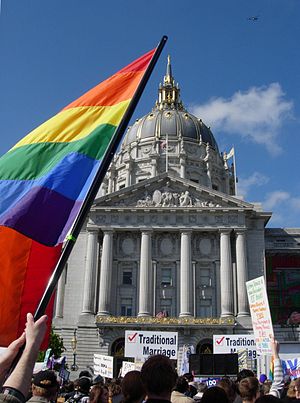|
Listen to this Article
|

Following the Supreme Court’s rulings on the Defense of Marriage Act (1 U.S.C. § 7 and 28 U.S.C §1738C) and California’s Proposition 8, those who committed themselves to the furtherance of civil rights felt rewarded and a part of the historic momentum underway.
It was only two short months ago that legally married same-sex couples across the country were being deprived of the “duties and responsibilities that are an essential part of married life,” even if their own home state legally recognized same-sex marriage. As Justice Kennedy wrote in the majority opinion in United States v. Windsor, 570 U.S. ___ (2013), the Defense of Marriage Act placed “same-sex couples in an unstable position of being in a second-tier marriage.”
Here in California, things were even worse for members of the LGBT community. Thanks to a fear-driven and well-funded campaign in 2008, the passage of Proposition 8 deprived same-sex couples in our state of a marriage certificate in addition to survivor benefits and other benefits withheld by the Defense of Marriage Act.
There is much to celebrate as leaders and citizens across the United States finally fully acknowledge that all humans are created equal under the law. In fact, it is tempting to fall prey to the idea that we as a nation have successfully made our way over to the right side of history. However, those of us in the legal profession know all too well the barriers that continue to confine these valuable citizens to second-class status.
Legislatures Behind the Times on LGBT Rights
In the last year, six states—Washington, Maine, Maryland, Rhode Island, Delaware, and Minnesota—became the latest states to legalize same-sex marriages. However, thirty-seven states have yet to extend such protections. In fact, less than half of all states offer any sort of legal protection for homosexual couples. Meanwhile, more than half have passed constitutional amendments either limiting or completely withholding legal protection for same-sex couples.1
This reality serves as only one measure of how far we still have left to go. Furthermore, although marriage is certainly an important issue and has understandably been at the top of the agenda for many of the organizations that have mobilized support for LGBT rights, the push for equality far surpasses this one issue.
It only seems appropriate that we find ourselves commemorating the 50th anniversary of the March on Washington and Martin Luther King’s “I Have a Dream” speech as our attention is being called to the rights of yet another historically marginalized segment of our American society.2 Much like the Civil Rights Movement of the 1960s, the push for LGBT rights has extended beyond the altar and into our places of business. In the last year alone, we saw headlines of a gay couple being kicked out of a mall for kissing and holding hands, and another couple being dumped on the side of a rain-drenched highway by a cabbie who decided that an innocent kiss by a same-sex couple was the equivalent of “making sex” in the back seat. In a similarly despicable incident, a lesbian couple was left on the side of a busy Oregon highway after being verbally lambasted by their cab driver for holding hands and kissing.3,4,5
California Offers Effective Legislative Model for Civil Rights
As it currently stands, the language of Title VII of the Civil Rights Act of 1964 (42 U.S.C. § 21) only explicitly extends protection against discrimination on the basis of race, color, religion, sex or national origin. This stands in stark contrast to the approach taken by states like California, who have passed laws protecting consumers and employees from discrimination based on a far more comprehensive list of protected categories.
Under the Unruh Civil Rights Act (Cal. Civ. Code § 51et seq.), California picks up where the Civil Rights Act left off by offering the following protection (emphasis added):
All persons within the jurisdiction of this state are free and equal, and no matter what their sex, race, color, religion, ancestry, national origin, disability, medical condition, genetic information, marital status, or sexual orientation are entitled to the full and equal accommodations, advantages, facilities, privileges, or services in all business establishments of every kind whatsoever.
The state takes a similarly comprehensive approach with respect to employment. Through the California Fair Employment and Housing Act (Gov. Code § 12900 et seq.), employees and tenants are provided with legal recourse in the event that they are discriminated against on the same set of protected categories, with the notable additions of gender identity and gender expression.
Several states have followed this model and offer legal recourse to those subjected to discrimination based on their sexual orientation. Nevertheless, many have still not passed any such laws protecting their LGBT citizens from this kind of discrimination. Even the federal government remains reluctant to expand the Civil Rights Act to prevent discrimination on the basis of sexual orientation. This is perhaps more disconcerting because a legislative fix entitled the Employment Non-Discrimination Act (ENDA) has been introduced in every Congress since 1994, but to no avail.6 The proposed statute would prohibit discrimination in hiring and employment on the basis of sexual orientation and gender identity. However, despite having more than 100 co-sponsors the first time it was introduced, a shift in the political composition of Congress that year dashed all hopes of its passage and set the tone for the decade that has since passed.7 As a result of such foot-dragging, employers have remained free to harass, discriminate against, and exclude this historically oppressed group from commercial activity with impunity.
That said, as tempting as it is to celebrate our nation’s progress with respect to LGBT rights, it is equally easy to let harsh realities such as these distract us from the trajectory on which we find ourselves as a country. While state and federal legislatures may be slow to bring our laws into the twenty-first century, the courts have been recognizing that existing law may already provide the necessary protection to put a stop to the marginalization that legislators seem reluctant to acknowledge.
Courts Recognize Legislative Purpose In Existing Statutes
In addition to the Supreme Court’s landmark decision in Windsor and the effective death blow it dealt Proposition 8 by refusing to rule in Hollingsworth v. Perry, 570 U.S. ___ (2013), there is a slower, more subtle trend afoot with respect to the employment and consumer rights of LGBT citizens.
Although it may not have been intended to provide such a basis when it was decided, it actually began with a 1989 Supreme Court decision regarding Title VII. In the matter of Price Waterhouse v. Hopkins, 490 U.S. 228 (1989), the Court ruled in favor of the plaintiff, Ann Hopkins, who was refused a promotion to partner on the basis that she did not fit the expectations associated with femininity. Management at Price Waterhouse went so far as to suggest that what Ms. Hopkins needed was a “course in charm school.” In fact, they told Ms. Hopkins that she needed to “walk more femininely, talk more femininely, dress more femininely, wear make-up, have her hair styled, and wear jewelry” if she wanted to be seriously considered for the promotion.
In its ruling, the Court observed that, but for their criticisms of Ms. Hopkins’ supposed lack of feminine qualities, the employer lacked any other basis for denying her the promotion. Thus, the Court ruled that Price Waterhouse violated Title VII’s prohibition against gender-based discrimination. More substantively, the Court held that once a plaintiff demonstrates that gender was a motivating factor in an employment decision, the burden then shifts to the employer to show by a preponderance of the evidence that it would have made the same decision irrespective of gender—or in this case, those stereotypes associated with a specific gender.
Whether the Court knew it or not, the recognition of a right against discrimination based on gender stereotypes would eventually provide the necessary foundation for LGBT citizens to assert their rights in the workplace.
In fact, Hopkins served as such in 2009, in the matter of Prowel v. Wise Business Forms, Inc., 579 F.3d 285 (3d Cir. 2009), when the Third Circuit overruled a trial court’s decision to dismiss a discrimination case filed by a homosexual male employee. During his employment with Wise Business Forms, the plaintiff, Brian Prowel, complained about co-workers calling him derogatory names, leaving him obscene notes, and even prayer cards from his more religious coworkers. More notably, however, was the way Mr. Prowel recalled his more masculine coworkers responding to his behavior:
In stark contrast to the other men at Wise, Prowel testified that he had a high voice and did not curse; was very well-groomed; wore what others would consider dressy clothes; was neat; filed his nails instead of ripping them off with a utility knife; crossed his legs and had a tendency to shake his foot “the way a woman would sit”; walked and carried himself in an effeminate manner; drove a clean car; had a rainbow decal on the trunk of his car; talked about things like art, music, interior design, and décor; and pushed the buttons on the nale encoder with “pizzazz.”
Although the discriminatory conduct was blatantly homophobic in nature and would have been more easily actionable with a statute such as ENDA that explicitly barred such conduct on the basis of sexual orientation, the gender-based nature of the conduct itself was found to be sufficient for Mr. Prowel to have standing. In its ruling, the Third Circuit held that the employee had standing to sue under Title VII as his argument was that his employer discriminated against him on the basis that he did not conform to expected male norms. Specifically, Judge Hardiman wrote, “There is no basis in the statutory or case law to support the notion that an effeminate heterosexual man can bring a gender stereotyping claim while an effeminate homosexual man may not.” That is, so long as the argument is couched in language of gender stereotypes rather than sexual orientation, Title VII offers a legal basis for homosexual employees to use as a means to obtain similar ends.
Last year, that same argument was made available to transgender employees seeking protection under Title VII. In the matter of Macy v. Holder, Appeal No. 0120120821 (U.S. Equal Employment Opportunity Commission, Apr. 20, 2012), the commission determined that an employment decision made based on the fact that an employee is transgender violated the Civil Rights Act of 1964 on its face.
Citing to the aforementioned Price Waterhouse decision, the commission found that when an employer discriminates against an employee for being transgender, such discrimination is nevertheless “related to the victim’s sex” irrespective of whether such treatment is “because the individual has expressed his or her gender in a non-stereotypical fashion, because the employer is uncomfortable with the fact that the person has transitioned or is in the process of transitioning from one gender to another, or because the employer simply does not like that the person is identifying as a transgender person.” Although the courts are not obligated to follow EEOC rulings, such decisions have regularly provided a source of guidance to the courts, especially in matters with relatively nuanced subject matter.
Civil Rights: Mutual Interest vs. Mutual Demise
Needless to say—and notwithstanding the unwillingness of the legislature—progress is being made. Specifically, it appears that the courts have embarked on the long, deliberate process toward determining that a failure to at least effectively extend these rights to LGBT citizens would serve to compromise the ultimate purpose of these longstanding laws.
As MLK observed while in the throes of the Civil Rights Movement, “[T]he arc of the moral universe is long, but it bends toward justice.” Justice is not a fixed target, but a moving one. We move ever closer with each progressive step we take, yet we never actually arrive. In the pursuit of perfect justice, we find that there is really no such thing. However, there is no reason to see this reality as bleak. Instead, it should serve as reassurance that there will always be more to do, that there will always be more that we can do to ensure that fewer people are left on the fringes of society.
Therefore, we find ourselves in a unique position as members of the legal profession. From private practitioners to judges to policymakers, it is incumbent upon us all to see the opportunity we have before us and the social duty we have to use our expertise to affect a more just legal system. Regardless of political ideals and affiliations, we must be willing to look past these narrower interests so that we may continue to inch closer toward that ever-elusive goal.
“Injustice anywhere is a threat to justice everywhere. We are caught in an inescapable network of mutuality, tied in a single garment of destiny. Whatever affects one directly, affects all indirectly.”
True to MLK’s words, the present struggle toward greater equality—at the present moment, for the LGBT members of society—is a shared one, in which all have an interest. We cannot support, or even allow for, the denial of basic rights to one segment of the population without simultaneously risking those rights for ourselves. Thus, the only question that remains is whether we will see this opportunity for what it is, or if we will allow ourselves to continue missing the forest for the trees.
Sources Cited
1 Freedom to Marry, Inc. and Freedom to Marry Action, Inc., “Where State Laws Stand,” available at www.freedomtomarry.org/pages/where-state-laws-stand (last visited August 27, 2013).
2 Voice of America, “US Celebrates 50th Anniversary of Civil Rights March,” available at www.voanews.com/content/us-celebrates-50th-anniversary-of-civil-rights-march/1735973.html (last visited August 27, 2013).
3 Christine Roberts, “Gay Couple say they were asked to leave California mall for kissing,” New York Daily News, available at www.nydailynews.com/news/national/gay-couple-asked-leave-california-mall-kissing-article-1.1279990 (last visited August 27, 2013).
4 CBS Chicago, “Two Men Say Cabbie Ejected Them For Kissing,” available at chicago.cbslocal.com/2013/05/31/two-men-say-cabbie-ejected-them-for-kissing/ (last visited August 27, 2013).
5 Maxine Bernstein, “Broadway Cab driver suspended after allegedly forcing same-sex couple out on I-84,” The Oregonian, available at www.oregonlive.com/portland/index.ssf/2013/07/broadway_cab_driver_suspended.html (last visited August 27, 2013).
6 American Civil Liberties Union, “Employment Non-Discrimination Act,” available at www.aclu.org/hiv-aids_lgbt-rights/employment-non-discrimination-act (last visited August 27, 2013).
7 National Gay and Lesbian Task Force Foundation, “History of Nondiscrimination Bills in Congress,” available at www.thetaskforce.org/issues/nondiscrimination/timeline (last visited August 27, 2013).




